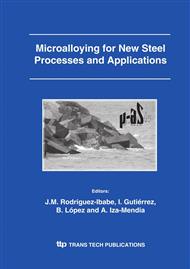p.663
p.669
p.677
p.687
p.695
p.703
p.711
p.719
p.729
Vanadium Carbide Dissolution during Austenitisation of a Model Microalloyed FeCV Steel
Abstract:
High performance commercial micro alloyed steels contain elements such as vanadium, which leads to a fine dispersion of vanadium carbide precipitates. The precipitation state, in terms of volume fraction and size distribution, plays a significant role in final mechanical properties of the material. Different austenitisation heat treatments were performed on a model ternary alloy FeCV. Precipitation states were characterised combining different experimental techniques. TEM was used to identify the chemical composition of observed precipitates. ICP mass spectroscopy was performed to measure the volume fraction of precipitates. The size distribution was studied by SEM. Results are characteristic of a coarsening regime.
Info:
Periodical:
Pages:
695-702
Citation:
Online since:
November 2005
Keywords:
Price:
Сopyright:
© 2005 Trans Tech Publications Ltd. All Rights Reserved
Share:
Citation:


